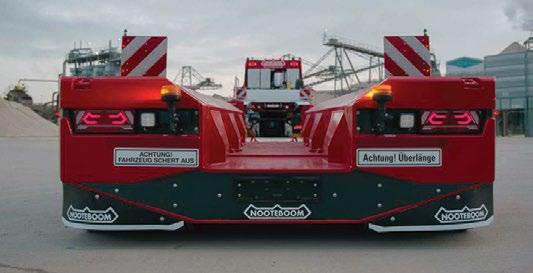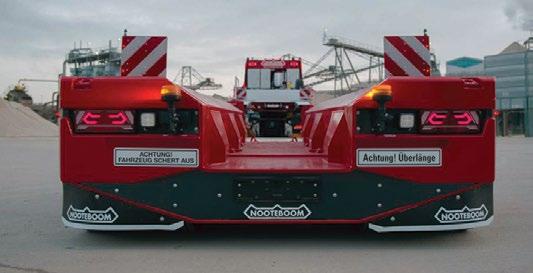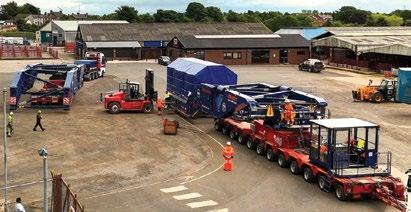
5 minute read
Transport & Trailers
The next gen low loaders
Nooteboom Trailers has launched the Euro-PX3, its 3rd generation of Euro-PX low loaders with pendulum (swing) axles and significant improvements in increased payload, a wider trough providing more space and flexibility for oversized loads, a bigger steering angle for better maneuverability and control, a new steering system to reduce tyre wear and a lightweight chassis.
Available with two or three axle lines, the Euro-PX3 has a load capacity of 12 or 14 tonnes per axle at 80 kph. It is available in vehicle widths of 2.54, 2.74 or 2.84 metres, axle distances of 1.36 or 1.51 metres and 245/70R17.5 or 285/70R19.5 tyres. The axle bogie has new bearings, simplifying maintenance and reducing long-term costs.

Nooteboom has been producing low loader trailers since 1953 and launched the original Euro-PX in 2005. This year the PX range has been redesigned with hydraulically steered swing axles. Combination options in the near future include Jeep dolly and Interdolly configurations for extra load capacity.
Complex stator transportation
Careful planning and collaboration with local authorities were required by UK based heavy transport provider Collett and Sons to successfully complete the 92 mile transportation of a 234 tonne stator from Heysham Port to Gretna Grid Stability Facility, Scotland.
At the port the stator - measuring 9.1 metres long, 4.2 metres wide and 3.9 metres high - was loaded onto a 12 axle modular flattop trailer to shunt it within the port for temporary storage. To facilitate self-loading, Collett’s 24 axle 350 tonne capacity Scheuerle girder bridge trailer was built around the stator ensuring efficient loading operations.
The stator - accompanied by Collett’s escort fleet and Lancashire police - set off from the port but due to the length and weight of the girder bridge trailer several complex manoeuvres and strategic adjustments were required. One included temporarily stopping motorway traffic to turn the trucks around and contraflow a joining slip road to avoid a weak bridge structure.

After 88 miles the load reached the transition point at Longtown and was self offloaded onto temporary stools and the girder bridge demobilised. At this stage a 16 axle Self-Propelled Modular Trailer (SPMT) was driven under the stator to lift it off the stools eliminating the need for a large mobile crane. The SPMT provides 360 degree steering and vertical lifting or lowering of the load over shorter distances where route access is limited such as the various bridges that had to be navigated. The load was safely chained down for the final four mile leg of the journey to the Gretna Grid Stability Facility, driven at a two kph walking pace.
To ensure clear passage on the route, trees had to be trimmed and some street furniture removed. Additionally, a thorough structural report was made to ensure that two bridges dating back to the late 1800s, could support the combined weight of the SPMT and stator.
Upon arrival, limited space at the facility meant the stator was temporarily offloaded onto stools and the SPMT was reconfigured to 11 axles enabling the trailer to make a 90 degree turn for unloading inside the building.
The Gretna Grid Stability Facility, featuring a 60 MVA synchronous condenser, will boost grid stability by providing short-circuit and inertia power, as well as reactive power compensation to support distribution networks with a high share of renewable energy.

Relocation of crusher parts
Mining equipment is never permanent as once an area is exhausted, equipment must be moved to a new location to continue operations. Chile’s state owned copper mining company Codelco has mines near the city of Calama in the north of the country and sought guidance from heavy lift and transport specialist Mammoet on the best method to move massive key crusher parts - the largest weighing 1,300 tonnes4.5km from one site to another.

In all, 16 components - including six of the largest making up the crusher system - had to be moved. Mammoet proposed a series of different extraction methods to allow the key components to relocate as whole units, reducing cost and resulting in the project finishing earlier than expected.
One of Mammoet’s biggest challenges was sourcing and mobilising all the equipment and personnel for the huge project. To bolster the equipment that was already available in Chile, additional SPMTs were brought in from Malaysia, skidding systems from the US, and other equipment was sourced from Colombia.
There were six key components to relocate, and the method for removal and transporting was different for each. Most were lifted using climbing jacks and then relocated with SPMTs fitted with support beams. The drive system used the same approach but with the addition of a skidding system used to slide the component twelve meters before it could be jacked down into its final position.
The two heaviest items were the 1,100 tonne silo and the 1,300 tonne crusher - the latter being the most complex of the six cargo movements. The crusher was extracted from its housing using skid tracks and skid shoes before being lifted into the air high enough for SPMTs to move underneath. Lashing was used to add additional support and hold everything in position during the 4.5km journey.
Once at the installation site, the earlier process was repeated in reverse, with SPMT trailers lowering the cargo onto skid tracks to slide it back into its new position. The operation was completed in just over a month - less time than was expected due to crusher parts being removed as complete units - and included a team of 70 people, 160 axle lines of SPMT, eight 500 tonne skid shoes, eight 400 tonne jacking systems as well as support beams, rails, and lashings.








